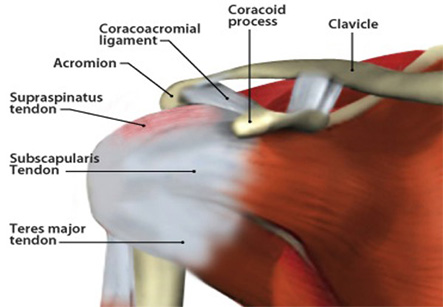Rotator Cuff Tendon
Introduction
One of the most common physical complaints is shoulder pain. The shoulder is made up of several joints combined with tendons and muscles which allow a great range of motion in the arm. Because so many different structures are involved in the shoulder joint, it is vulnerable to many different problems. The rotator cuff is a common source of pain in the shoulder.
Anatomy
The shoulder is made up of three bones: the upper arm bone (humerus), shoulder blade (scapula), and collarbone (clavicle).
The arm is held in the shoulder socket by the rotator cuff. These muscles and tendons form a covering around the head of humerus.
There is a lubricating sac called as bursa between the rotator cuff and the bone on top of the shoulder (acromion). The bursa functions to allow the rotator cuff tendons to glide freely while moving the arm.
Iran ranks among the top 10 countries in orthopedics and Iranian surgeons perform high quality orthopedic surgeries at highly affordable prices

The rotator cuff is a common source of pain in the shoulder. Pain can be the result of:
1. Tendinitis- The rotator cuff tendons can be irritated or damaged.
2. Bursitis- The bursa can become inflamed and swell with accumulation of fluid causing pain.
3. Impingement. After raising the arm to shoulder height, the acromion rubs against or impingeson the tendon and the bursa, causing irritation and pain.
Cause
Young athletes who use their arms overhead for swimming, baseball, and tennis are particularly vulnerable. Activities involving repetitive lifting of arm in case of paper hanging, construction, or painting can also lead to this problem. It can also occur in middle aged people.
Pain may also develop as the result of a minor injury. Sometimes, it occurs with no apparent cause.
Symptoms
1. Swelling and tenderness in front of the shoulder
2. Pain while lifting the arm or lowering it from an elevated position.
3. In early stages of the disease, symptoms such as minor pain on activity, radiating pain from shoulder to side of the arm, and sudden pain with lifting movements or throwing a ball can occur.
4. In later stages, there may be pain at night, loss of strength and motion, difficulty to place the arm behind the back and in severe cases all movement of shoulder may be limited and painful.
Diagnosis:
Medical History and Physical Examination
After discussing the symptoms and medical history, the doctor tests the range of motion by moving the arm in different directions. He or she also tests the arm strength.
The doctor also examines the neck to rule out a pinched nerve and arthritis.
Imaging Tests
After surgery, the arm may be placed in a sling for a short period of time.
X-rays: The plain x-rays of a shoulder with rotator cuff pain are usually normal or may show a small bone spur. A special x-ray view, called as the outlet view can sometimes show a small bone spur on the front edge of the acromion.
Magnetic resonance imaging (MRI) and ultrasound: These studies can produce better images of soft tissues including the rotator cuff tendons. Inflammation in the bursa and partial tearing of the rotator cuff can also be diagnosed.
Treatment
The treatment plan depends on the age, activity level, and general health of the patient.
Conservative Treatment
This treatment is can cause a gradual improvement in symptoms and return to function. This includes:
1. Rest. Rest and activity modification is advised, such as avoiding overhead activities.
2. NSAID’s- Drugs such as ibuprofen and naproxen can reduce pain and swelling.
3. Physical therapy. Stretching exercises to improve range of motion are very helpful, especially if the patient has difficulty in reaching behind the back. As the pain starts improving, the therapist can start a strengthening program for the rotator cuff muscles.
4. Steroid injection. If all above approaches do not relieve the pain, an injection of a local anesthetic and a cortisone preparation in the shoulder may be helpful. Cortisone is a very effective anti-inflammatory medicine. It can relieve painful symptoms.
Surgical Treatment
When nonsurgical treatment does not relieve pain, the doctor may recommend surgery.
The goal of surgery is to create more space for the rotator cuff.
1. Open surgery. By taking an incision on shoulder. This can include:
• Removal of the inflamed portion of the bursa
• Anterior acromioplasty, in which part of the acromion is removed.
2. Arthroscopic technique. In this, very thin surgical instruments are inserted into two or three small puncture wounds around the shoulder. The doctor examines the shoulder through a fiberoptic scope connected to a monitor. Bone spur and inflamed soft tissue can be removed.
Other conditions such as shoulder arthritis, biceps tendonitis, or a partial rotator cuff tear can also be treated at the same time.
Rehabilitation
After surgery, the arm may be placed in a sling for a short period of time. This allows for early healing. As soon as the comfort allows, the doctor will remove the sling. After this, exercises to regain range of motion of the shoulder and strength of the arm can be started. It typically takes 2 to 4 months to achieve complete relief of pain, but it may take up to a year.